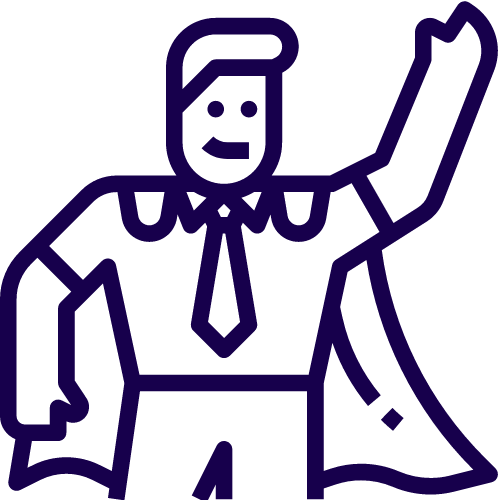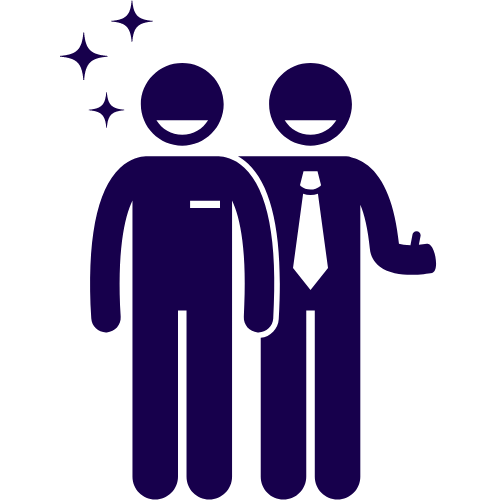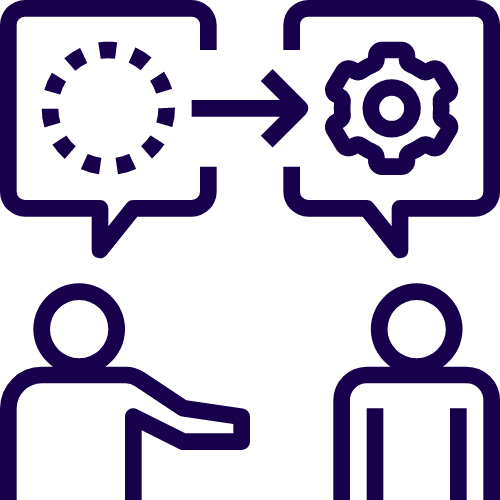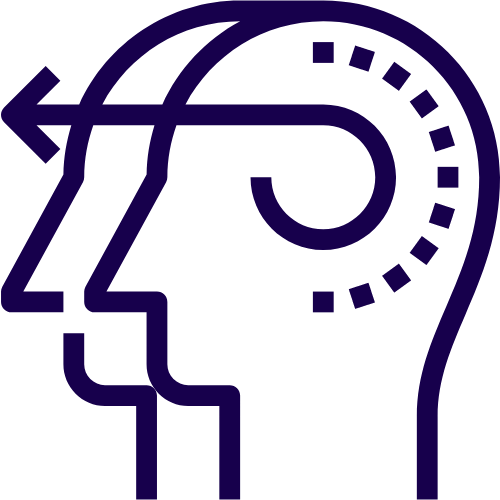




What do we do
We believe that today, only those organizations that turn development into a continuous process will survive and thrive. In this ever-changing environment, many companies are quickly getting old and can no longer respond to internal and external challenges. Our experiences made us see that often times, existing organizational systems may become a hindering factor for employees’ development which can deprive them of the possibility of y utilizing their potential. On the contrary, a company may have robust systems in place (e.g., compensation system), and conduct certain trainings as well, but all of this may not be effective in providing motivation for development and making employees satisfied. There can be different reasons behind this – an employee may be in the wrong role/position, or they may not have the values and mindset of the organizational culture, etc.
|
|
|
|
|
|
|
|
|
|
|
|
|
|
|
|
|
|
|
|
|
|
|
|
 |
|
Company has a reputation of the best employer and is the best work place for talents |
|
 |
|
Employee and team effectiveness rates are high |
|
|
|
|
|
|
|
|
 |
|
Employees are satisfied and happy, their energy is productive and oriented on development and creating maximal value for clients |
|
 |
|
Company promptly reacts to internal or external changes, changes are effectively managed |
|
|
|
|
|
|
|
|
 |
|
On the expense of developed mentoring system, knowledge is promptly shared in the company and new employees are properly and quickly trained |
|
 |
|
Initiatives are frequent in the company, there are new innovative projects |
How we work
For us, individual and organizational development is a unified system and reviewed in the perspective of a company’s vision, ambition, strategic goals and values. We deem it important to re-evaluate these issues with the management team. This mostly happens through a facilitative workshop format. In addition, in order to study this issue more thoroughly, ACT carries out an HR audit (HR analytics, organizational structure, work descriptions, etc.), analytics of the existing studies and if needed, additional research (ONA – Organizational Network Analysis, employee satisfaction study), which enables us to make precise conclusions and implement the respective activities.

As we have already mentioned, often times, one of the factors hindering organizational development is the company’s structure and incorrectly distributed roles and responsibilities. They may not even respond to company’s goals and values, which may result in bureaucratic processes and prolonged decisions, ineffectiveness of employees and dissatisfaction in the company.
It’s a fact that hierarchy structures no longer respond to today’s challenges and this is why, more and more modern companies try to understand the concept of “organization as a network” which implies maximal decentralization, micro and multifunctional teams working with agile principle (link to agile).
As for studying employee satisfaction which is clearly important for successful operation, we use organizational network analysis (ONA) for this purpose. This toll enables us to discover what is natural structure, formal and informal connections in the company. Based on the results of analysis, we can help companies in creating organizational structure of roles, functions and competences, that in response to modern challenges, gives organizations room for more adaptation, flexibility and at the same time, achieving its strategic goals.

Obviously, motivational system is quite a complex issue and is not solely defined by salary and compensation policy. Based on our experience, it is very important to understand what we want to stimulate in the company. For example, if we want innovative culture, but we do not have budget for experiments and innovative ideas are not getting incentives, only declaration of this will not bring any results. It may be important to stimulate different things from year to year, even from quarter to quarter and established motivation and compensation system, unless it envisages similar factors, will not be effective.
Based on our observation, it is also very important to correctly define expectations, to clarify what will be the best result for everyone. To this end, we actively utilize facilitation workshop format, where management team members discuss specific suggestions and agree on main indicators of the compensation system. Based on our observation, only those compensation schemes are effective that are clear, measurable, realistic (financially implementable) and in compliance with specific roles / positions and strategic goals. We help organizations to establish exactly such systems.

Evaluation systems are one of the most sensitive topics for employees. It can even become a source of stress for them. In modern reality, it is becoming more and more important to work on strengthening leadership qualities and establishing the evaluation system that will make employees clearly see and accept its strong and under-developed sides, have better understanding of his/her role in the team and need of improving specific competences. Based on our experience, it becomes more and more effective to establish immediate evaluation system after finishing specific tasks which is more retrospective and envisages coaching approaches:
In the process of establishing and implementing our evaluation system, we actively incorporate clear, realistic and measurable indicators, coaching methods and debrief sessions, systems that motivate feedback. Based on the analysis of results obtained from those evaluation, we help companies in developing such development programs that will assist teams as well as individuals to achieve the best results.

Based on our observation, companies often spend generous resources on employees’ development, frequently held various trainings. However, those trainings may not turn effective and sometimes it may act in contrary – employee may perceive it as a certain pressure especially if trainings are held during non-working hours. There can be several reasons:
It is important development programs to be reviewed in unified strategic context. These programs must be based on needs analysis and clearly define the expectations – what is expected and how can it be measured. In addition, it is substantially important to openly communicate programs, demonstrate their importance and usefulness to employees, how they enable employee’s professional and career growth.
Development programs may be different for different teams, but in the end, they should serve achievement of the common goals. For example, it is effective for a team of leaders to develop programs that are focused on strengthening their leadership qualities, realizing their own as well as team’s strong and under-developed sides. As we believe that only through transformation of the management team, team leadership and development of leadership skills in separate individuals can company achieve qualitatively different results. We offer companies development programs tailored to their strategic vision. To this end, we incorporate needs analytics, performance evaluation indicators, workshops combined with trainings, individual coach and debrief sessions.

Together with the company’s strategy, timely and adequate internal communication plays significant role in organizational development and effective management of changes. When consistent and constant internal communication is hindered, information is incorrectly perceived, corrupted and misinterpreted, which naturally increases stress levels and negatively affects productivity of employees.
Reciprocal openness is important in communication, it is important management to inform employees, explain why this or that change takes place, how can it affect their work, what benefits it can bring to them individually and to the company. It is important for companies to create systems which will enable open dialogue and feedback between employees and management. We help organizations in establishing effective internal communication platforms and efficient feedback systems.

Based on our experience, complex, bureaucratic and disorganized processes often demotivate employees because such systems require solid time resources from them and respectively, this affects their effectiveness negatively. We share lean management principles which defines that every process that does not help employee do their job best is so called “trash” and freeing from them positively affects quality of work as well as satisfaction of employees.
When establishing HR processes in companies, we are guided by this philosophy and we believe that one of the important tools for optimization of processes is digitalization of those processes. We help organization to better fit to HR platforms, create systems / formats tailored to them in different directions, such as recruiting and integration (on boarding) of new employees, self-services (e.g. requesting a leave, updating personal information, access to benefits, etc.), recruiting systems, training and development, etc.

We believe that data analytics act as one of the best tools for objectively assessing the situation and making the right decision. Nowadays, it is vitally important for companies to gather data in a way to make the overall picture clear.
Properly organized HR analytics system enables us to regularly assess important indicators such as:
We strengthen companies in establishing a HR analytics system which enables management to clearly see the connections among different issues, make important conclusions in terms of the effectiveness of HR policy and plan the respective strategic steps.
„Culture is not just one aspect of the game – It is the game. In the end, an organization is nothing more than the collective capacity of its people to create value.“
Lou Gerstner, Jr. – IBM
We often come across of such a statement, in today’s world a transformation is not a choice, it is a new norm and whether you want it or not, the companies could not survive without it. But when is the best time to really transform an organization? Is it enough just to look at and look through the future of the industry and develop a new vision of the company to meet a new reality? Obviously, taking steps without having the right vision is more like wandering blindly in the forest, though in line with the vision it is most important to guess how sufficiently equipped we are; how much our values, competencies, skills, systems, or any other resources are capable to support us to follow the path to our future company with minor losses and essential creativity.
It is probably no news to anyone to say that the real transformation begins with one’s self. By realizing and analyzing the company's own leadership qualities, values, limiting beliefs and thoughts, and feeling its role and importance in the new vision of the company, the internal shifts that lead us to the first steps on the path of the change begin.
The key questions in the transformation process sound like this - where am I today and where do I want to be? What prevents me from getting where I want to get? What will help me to walk this path with minor losses and an environmentally friendly way? What are my leadership qualities and skills and what is my leadership energy like? In which role can I best demonstrate them?
These questions are quite difficult to answer, and if the company could not afford to create a field where the internal search process is invigorated, then the answers might also be superficial. Creating this field is the basis of a transformational organizational culture, and only on such a basement can a culture be built that can breathe with live, create and make a system shape accordingly to ensure the realization of a company's vision through the realization of individual human capabilities. The values in such a culture have a leading role where there is a vivid consensus in understanding them. All this is translated into the language of common game rules in daily activities, which is one of the major conditions to achieve the best results.
In today's fast-paced and unforeseeable world, revision of the structures and positions of the companies that have been successful for years but have lost their flexibility is now even more urgent and can no longer adequately respond to the challenges faced in the surrounding environment. Today it can be that in the same position, in the same company, different competencies and skills are prioritized for different time periods and that too is never enough. That is why it is extremely important to understand the roles together with the positions, to strengthen the team leadership along with the individual leadership, to meet the expectations instead of writing the detailed descriptions of functions and duties, to bring in the best results, to create projects to be done and to execute them as it is supposed according to project rules.
Too often in the companies where hierarchical systems are strictly determined, employees feel like being trapped within their own positions, often finding it difficult to see and recognize that the organizational vertical limits their ability to fully express themselves and their interests, while the brilliant results are achieved through flexible systems based on teamwork principles. In such hierarchical systems, the rules are canonized while the employees do not understand their importance, and the rules are followed without any enthusiasm, where it is forced, or even ignored, while horizontal arrangement and team principles vitalize the rule. The rule and the system can be understood not as a punishment, or as a hindrance, but as a support in order to do our job best. These are the changes that ACT underwent in the first stage of its transformation, as a result of which the organizational culture in the company today is a clear example of a living order.
Team play is seen as an integral part of a transformational organizational culture. It requires understanding and respect for your own and team members’ strengths and weaknesses. Successful team play is impossible without the ability to open up, recognize failure and success, share and self-reflection. It is also important to know how to speak a common language so that we do not lose our uniqueness; how to balance each other and overcome a task, the success of which often depends on the competence, skill, responsibility and concerted work of many people. Team leadership also implies the understanding of the fact that even the best qualities of a person can become a barrier if he is not in the right place and in the right role, and that all qualities are equally important for a magnificent success.
The Companies where equal importance is given to both the results and the way in which these results are achieved; as well as the Companies that are equally centered on the outside and the inside environment, achieve more glorious results, are innovators, and are resilient to storms threatened from the outside world.
ACT's unique management model, named The Power of Three, allows us to simultaneously see and implement the need for management and transformation in three areas. A real transformation is possible only if you have a clear vision of where you are going, and share the relevant values needed to realize that vision while they should come right from your heart. This could be done best through the development of systems and enforcement mechanisms. In such a model, the culture is congruent and organic to each employee of the company and ensures the maintenance of vitality and sustainability.
Our new reality is very much alike if you get up 15 minutes earlier to work day, go to “home office”, work, mix personal and work time, head over to your own kitchen during lunch, come across with shopping list when working on projects and mostly spend your weekends on the balcony. New reality makes our behavior and work principles homogenous. In the environment where homes are turned into offices a circle is formed where routine is repeated every day for everyone. How is it possible under these circumstances to keep your work motivation or even increase it?
When speaking about motivation, we most definitely need to mention Abraham Maslow, founder of motivation theory, whose pyramid cannot be avoided by any organization. On initial stage of keeping employees motivated, Maslow considers basic needs: physical environment and safety, following level is taken by psychological needs: belonging, love, recognition and finally, he sees the need of achieving one’s full potential and self-actualization.
According to Maslow’s hierarchy, organizations that fully meet employees’ needs from basic needs to top level, significantly increase their motivation. However, this classic model was altered by the pandemic. Now, employees who had their physical environment covered in terms of basic needs, have an upside down situation: they make stocks of food, pile up hygiene and medical products, stay at home and take care of their own and family member’s health. Under these changes, pyramid is completely altered and it becomes necessary to discuss changed tactics of employees’ motivation.
In Georgian reality, “upside down” pyramid appeared to be most simply adaptable for those companies whose organizational strengths became transferable into remote service as they already had digital processes well-established. To motivate employees, these and other companies had to make decisions based on the stage where large portion of their employees were at.
We are sharing an example of our organization – ACT, how it manages to preserve the bottom level of pyramid so that based on the central part, it supports lower and upper levels and respectively, increases employees’ motivation.
Love, friendship, family, belonging – central part of the pyramid, psychological factors largely affect motivation of employees. As far as ACT’s management follows direct, consistent communication, uses open, free, less bureaucratic approaches, acceptance of their decisions is already quite high. In addition to this, the majority of employees has long history of working for the company, thus, the feeling of love and belonging, supporting each other stands high on psychological level. A feeling of belonging is enhanced during a crisis, when people love to be united, to be in the same boat, this strengthens them mentally and simplifies acceptance of novelties, new initiatives. Being united against the problem from the company’s perspective is perceived as ultimate motivator, while being united around the idea is a powerful tool in the pursue to achieving goal.
Physical environment – new fears emerged in terms of physical level: preserving a job, salary, mobilization of finances for meeting basic needs, physical place to effectively do your job. These fears compromise lower level and to terminate this, organization needs to have timely and right communication with employees. To address this problem, ACT made certain changes in terms of staff/salary, which resulted in preserving jobs for every employee. This decision, on one side eliminated fears in terms of safety and physical environment and on the other side, on central level, built level of basic needs on membership of one big family. Employees became motivated to create safe working environment for them and their colleagues, thus, the company shortly became entirely digitalized.
Self-actualization – some of ACT’s employees were on the level of meeting the need of self-actualization, while part of them, with right allocation of resources, were given a chance to show off their “hidden” skills during the crisis. Opportunity to demonstrate their potential additionally motivated people to receive recognition from colleagues and level up to the last step of pyramid where by fully realizing their skills, they could turn the challenge into an opportunity. Clear demonstration of this is a new consulting platform of ACT – www.act-strategist.ge formed with the idea of supporting other businesses under corporate responsibility.
When evaluating the steps we made, organization was able to obtain a larger picture through a feedback tool (internal study), based on which motivation of employees has remained the same for 57% during crisis considering the decisions made by management while motivation increased for 33% of employees. Inquired staff members also believe that changes will not affect company’s work: on expectation level, they perceived that company would work in regular regime, while they feel optimistic towards the future operation of ACT. As verified by this example, if psychological needs are met, organization culture and feeling of being united is in place, building values on them becomes quite easy, which is particularly important during crisis.